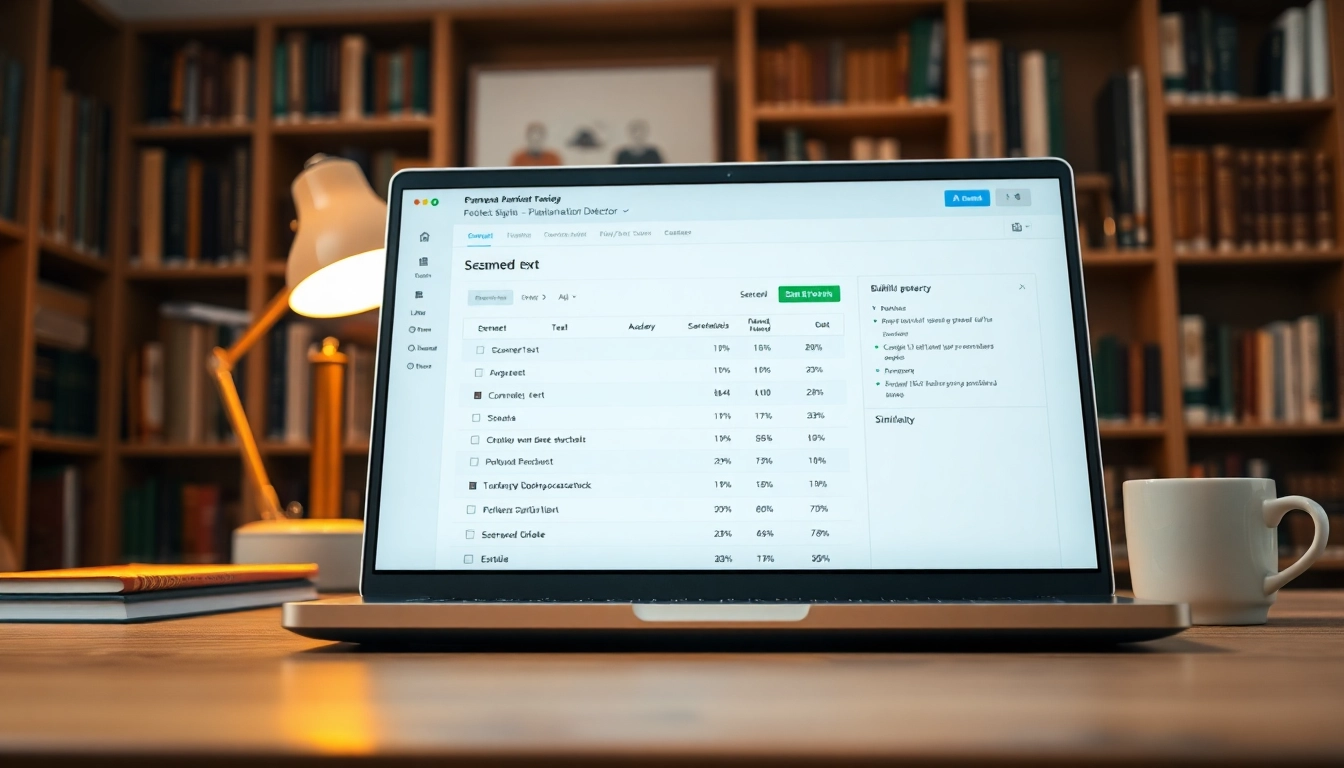Understanding Plagiarism Detection
In a world where the internet is brimming with information, ensuring the originality of content has become increasingly vital. Whether you are a student, a professional writer, or a researcher, utilizing reliable tools is essential for maintaining intellectual integrity. One such tool is a plagiarism detector, which can help you safeguard your work against unintentional duplication and uphold academic standards.
What is a Plagiarism Detector?
A plagiarism detector is a software tool designed to identify plagiarized content across various sources. By comparing submitted documents with extensive databases, the tool highlights similarities in text, guiding users in revising or citing content appropriately. These detectors cater to diverse needs, from academic papers to professional articles, ensuring the authenticity of written work by offering detailed reports on originality.
How Plagiarism Detection Works
The mechanics behind plagiarism detection involve several methodologies. Most detectors utilize advanced algorithms and databases to assess content. Here’s how the process generally unfolds:
- Text Submission: Users upload their documents into the plagiarism detection tool.
- Database Comparison: The software scans the text against its database, which includes web pages, academic papers, articles, and other published work.
- Algorithmic Analysis: Advanced algorithms analyze the relationships between words and phrases to identify matched content. Techniques such as fingerprinting and citation tracking may also be employed.
- Report Generation: Upon completion, the tool generates a report that specifies the percentage of original content, lists matched sources, and highlights areas of concern.
Importance of Plagiarism Detection in Academia
In an academic setting, the stakes surrounding plagiarism are substantial. Educational institutions uphold strict policies regarding originality, necessitating the need for effective plagiarism detection. Here’s why these tools are crucial:
- Maintaining Academic Integrity: Plagiarism undermines the core values of scholarship. The use of detectors ensures that students submit original work and adhere to ethical guidelines.
- Encouraging Original Thought: By identifying unintentional plagiarism, detectors encourage students and researchers to think critically and create original arguments.
- Facilitating Fair Assessment: Educators rely on these tools to maintain a level playing field for all students, ensuring that assessments are based on individual merit.
Key Features of Effective Plagiarism Detectors
Choosing the right plagiarism detector can greatly enhance your content’s authenticity and quality. Here are some essential features to consider:
Accuracy and Speed in Detection
A top-tier plagiarism detector must deliver both accurate results and quick processing times. Accuracy ensures that the tool can effectively distinguish between common phrases and genuine instances of plagiarism. Speed is equally important, especially in academic settings where deadlines are often tight. Users should look for tools that can process large documents efficiently without compromising on the quality of analysis.
User-Friendly Interfaces
An intuitive interface enhances user experience, making it easier for individuals of all technical skills to navigate the tool. Features such as drag-and-drop functionality, clear instructions, and straightforward report presentations are indispensable for facilitating smooth operations. Additionally, support for multiple languages can broaden accessibility for non-English content.
Compatibility with Various Formats
Plagiarism detectors should accommodate a range of file formats, from Word documents to PDFs and even HTML. This flexibility allows diverse users to run checks on different types of content without needing to convert files into specific formats. Furthermore, the ability to check content on various platforms, including academic management systems, enhances the tool’s viability for institutional use.
Comparing Popular Plagiarism Detectors
To select the best plagiarism detector for your needs, it’s beneficial to assess and compare the leading tools available in the market. This section provides an overview of some popular options, their strengths, weaknesses, and pricing considerations.
Overview of Leading Tools
Several highly-rated plagiarism detectors have established themselves in the market. Below are a few notable examples:
- Grammarly: Primarily known for its grammar-checking capabilities, Grammarly also offers a plagiarism detector that scans across various databases, ensuring content originality.
- Scribbr: Positioned as a robust academic tool, Scribbr is known for its accuracy in detecting plagiarism, particularly in heavily edited texts.
- Turnitin: Widely adopted in educational institutions, Turnitin provides comprehensive plagiarism detection and is integrated into many learning management systems.
Strengths and Weaknesses of Top Competitors
While many detectors claim to be the best, comparing their strengths and weaknesses helps users make informed decisions:
- Grammarly:
- Strengths: Integrated grammar checks, user-friendly interface, and real-time suggestions.
- Weaknesses: Limited database compared to dedicated plagiarism tools.
- Scribbr:
- Strengths: Highly accurate plagiarism detection, excellent customer support.
- Weaknesses: Subscription model can be expensive for occasional users.
- Turnitin:
- Strengths: Extensive database and institutional credibility.
- Weaknesses: Primarily available through educational institutions, making it less accessible to individual users.
Price vs. Features Analysis
When evaluating a plagiarism detector, analyzing the pricing structure in relation to features is key. Most detectors operate under different pricing models, including subscription-based services and one-time purchase options. Understanding your needs—whether for academic, professional, or casual use—will guide you in selecting a detector that offers value for money.
Choosing the Right Plagiarism Detector for Your Needs
Every user will have different requirements for a plagiarism detector based on their specific use cases. Below are critical considerations to help you choose the tool that fits your situation best:
Assessing Your Use Case
Different users may require different features in a plagiarism detection tool based on their objectives. For instance:
- Students: May need a reliable tool that highlights potential issues and suggests improvements.
- Research Professionals: Often require comprehensive reports and access to extensive databases to ensure the originality of published works.
- Content Marketers: Need fast and accurate detection to craft unique articles while maintaining content quality and SEO standards.
Budget Considerations
Cost is always a consideration. Many plagiarism detectors offer free versions with limited capabilities, while others offer premium features for a fee. It’s important to balance budget constraints with necessary functions to ensure you don’t compromise on quality.
User Recommendations and Reviews
Utilizing online reviews and user testimonials can provide valuable insights into a plagiarism detector’s performance and reliability. Platforms like G2 and Capterra gather user feedback which can highlight potential issues or praises. Additionally, joining forums or discussion groups within academic or writing communities can facilitate insights into which tools others find effective.
Maximizing the Benefits of Plagiarism Detectors
Implementing a plagiarism detector into your workflow can greatly enhance content integrity. Here are strategies and best practices to ensure efficient use:
Strategies for Efficiently Using Detection Tools
To maximize the utility of plagiarism detectors, consider the following strategies:
- Run Regular Checks: Make it a habit to check content frequently, especially before submissions or publication. Early detection allows ample time for corrections.
- Integrate into Writing Processes: Utilize the detector as a part of your writing workflow—check drafts regularly rather than waiting until completion.
- Educate Yourself: Familiarize yourself with common pitfalls that could lead to unintentional plagiarism, such as improper citation practices.
Integrating Detectors into Academic Workflows
For academics, it is essential to seamlessly integrate plagiarism detectors into existing workflows. This might involve establishing institutional subscriptions for students and department staff, conducting training sessions to ensure effective usage, and creating guidelines on best practices for detecting and addressing plagiarism.
Responding to Detected Plagiarism: Best Practices
Receiving a plagiarism report can be daunting, but it’s an opportunity for learning and improvement. Here are best practices on how to respond:
- Review the Report: Analyze the findings thoroughly to understand where improvements are needed.
- Revise Your Work: Make necessary changes to eliminate or properly attribute any plagiarized content.
- Learn from Mistakes: Use the experience as a teaching moment to ensure similar mistakes are avoided in the future.



